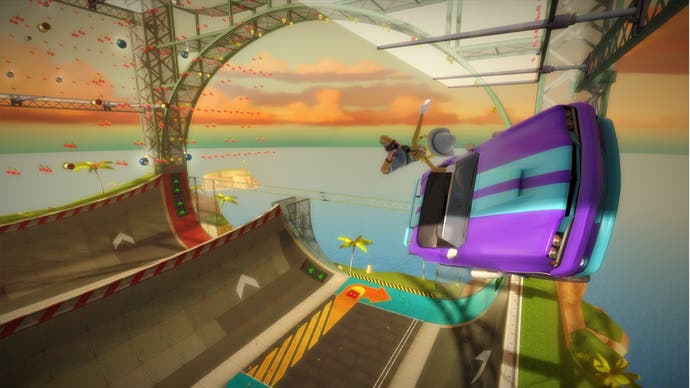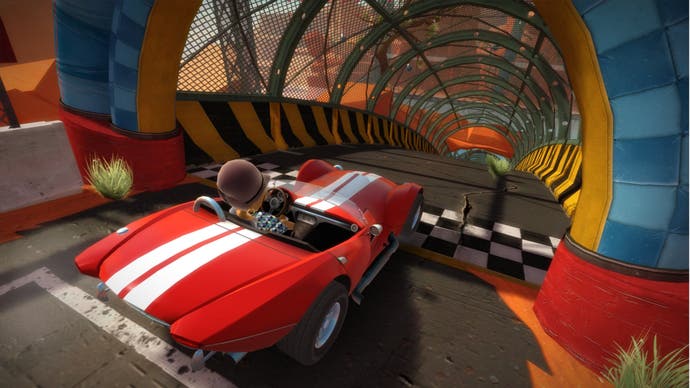Kinect visionary talks tech
"We decided to have our cake and eat it too."
It's clear that Kipman doesn't want to talk about specifics in terms of latency, preferring instead to discuss the sheer technical challenge of working in a controller-free environment. However, other developers have addressed the latency issue directly. Rare talk about a 150ms latency in Kinect Sports, for example.
We've played the pre-production Project Natal and saw end-to-end latency, including the flat panel display, in the order of 200ms - a fifth of a second. Give or take a frame and factor in display lag and we have a timing close to the same 150ms. Similarly, we played the far more up-to-date E3 demos using production standard sensors and the lag was identical. However, in both cases we were using Kinect Adventures' Rallyball/Ricochet demo as a point of reference - this is using a range of Microsoft libraries that scan one or two people, track skeletal movement from the depth data and then retarget that onto on-screen Avatars. Kinect Sports does the same thing, so it stands to reason that ballpark latency is the same.
A driving game, focusing on depth information mostly from the hands and not running the Avatar skeletal re-targeting to the same level will require far simpler dynamics and - we would imagine - could be processed quicker.


In discussing Kinect Adventures, Alex Kipman also discusses what we assume is the process of smoothing data. Jumping in the game can feel a touch less responsive, and Kipman's response is quite revealing.
"On the jumping side, you have to think about the amount of fun people are having in the living room. This is the part where I say, we playtested the crap out of this game. If you have kids moving up and down, the last thing you want to do is have a false positive," he says.
"The last thing you want to do is have that raft or the obstacle course, or the avatar somewhere jumping when you are not jumping. If you take little kids, running around the room, this is where the human lag comes into play. You look at it and you say, 'how do I ensure, positively, that really was a jump?' How to make sure it wasn't just a crouch?
"Think about the range of human motions. If I just crouch, and lift myself really quickly, how's that different from a jump? The answer is that you can detect those things, but you have to be very careful. This is where the game is tuned to make sure that you are building trust in the robustness of the platform. The last thing we wanted was to be getting a lot of false positives on River Rush because people in our playtest lab were having tons of fun, playing it.
"So I'm not saying there's a half a second of lag, in that game, but I will say that, for the thing that you talked about, it's more about being intentional about design and making sure we're only actuating mechanics and actions when we're one hundred per cent sure that they've occurred in the living room."
Sifting and shorting through the data essentially becomes a process of interpretation then, a process that Alex Kipman likens to tuning gameplay in a conventional console title.
"Think about the difference between a Forza and a PGR. One has an arcadey feel to it, the other one has a simulation feel to it. As a game designer I choose where I put the needle," he explains.
"If I'm a Forza designer then I'm going against the demographic of customers that really enjoys the simulation level of the experience. I'm going to be extremely precise, to the point that, if you're not good, you're not going to be able to drive the car.
"Project Gotham Racing is made to be much more approachable. More arcadey in its driving, less simulation. It allows for a different type of experience. The same is true here, and I'll use the two examples... Dance Central is made to be a simulation type game. You're simulating dancing – you want it to be precise, you want it to be real-time and guess what? If you're not good at it, you're just going to suck at dancing...
"Take Kinect Adventures, the needle moves to a different side. It is made to be a fun, simple, approachable game that gets people acquainted with the platform. Those remain toolsets - paint colours and paintbrushes that game designers, the storytellers, get to choose. I think you'll see that the platform has range, that it has the range to go down a more real-time simulation, all the way out to a less simulation sort of game."
The full GI.biz interview is well worth a read, with a second part coming tomorrow. While Alex Kipman expertly side-steps a fundamental question or two, his comments do serve to remind us that Kinect is truly a remarkable evolution in console gaming. The sheer technological achievement in bringing a fully featured real-time motion capture system to the Xbox 360, with support for multiple players and without sapping too much in the way of the console's resources is something of a miracle that perhaps gets overlooked.
But while cool tech is one thing, questions still need to be answered concerning the quality of the gameplay experience. Does the first wave of Kinect titles deliver? The first Eurogamer Kinect reviews hit tomorrow...
